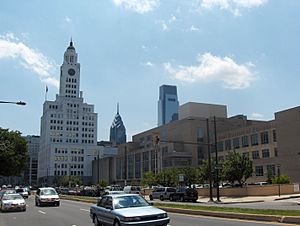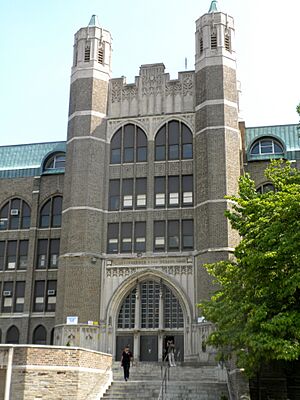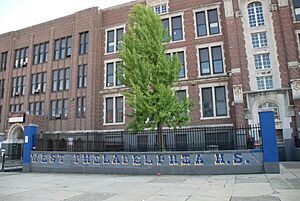School District of Philadelphia facts for kids
Quick facts for kids School District of Philadelphia |
|
|---|---|

The Philadelphia Board of Education Building, the district's headquarters, at 440 North Broad Street (in the right foreground)
|
|
| Location | |
| 440 North Broad Street Philadelphia, Pennsylvania 19130 United States |
|
| Coordinates | 39°57′39″N 75°09′46″W / 39.960752°N 75.162646°W |
| District information | |
| Type | Public |
| Grades | Pre-K–12 |
| Established | 1818 |
| President | Reginald L. Streater, Esq., |
| Superintendent | Tony Watlington |
| School board | Board of Education |
| Schools |
|
| Budget | $4.3 billion (FY23) |
| District ID | 4218990 |
| Students and staff | |
| Students | 197,288 (2022-2023) |
| Staff | 22,590 (excludes charter schools) (April 1, 2023) |
| Other information | |
| Teachers' union | Philadelphia Federation of Teachers (PFT) |
| Administrators' union | Commonwealth Association of School Administrators (CASA) |
The School District of Philadelphia (SDP) runs all public schools in Philadelphia. It started in 1818. It is the biggest school district in Pennsylvania. It is also the eighth-largest school district in the entire United States. As of 2022, it serves over 197,000 students.
A school board was created in 1850 to manage Philadelphia's schools. Later, judges appointed members to this board. This was done to keep politics out of school management. Over time, the mayor began appointing the school board.
In 2001, the state took control of the district. The governor then appointed most members of a new group called the School Reform Commission. In July 2018, the School Reform Commission ended. Control of the district went back to the city. A new Philadelphia School Board was chosen.
Contents
Schools in Philadelphia
The School District of Philadelphia runs many schools. It has 151 elementary and K-8 schools. There are also 16 middle schools and 57 high schools.
There are also 83 public charter schools. These schools operate independently. However, the School District of Philadelphia allows them to open. They are also responsible to the district.
Student Population
In September 2019, about 203,225 students were enrolled. These students attended schools run by the district.
Many students speak languages other than English at home. In 2014–2015, students spoke 107 different languages. Spanish was the most common language. About 6,260 students spoke Spanish at home. This was 52% of students who spoke another language. Other common languages included Mandarin Chinese, Arabic, and Vietnamese.
In December 2013, about 60,774 students attended charter schools.
How the District is Organized
The School District of Philadelphia is the only school district in Philadelphia. Philadelphia is the sixth-largest city in the United States.
Before 2012, the district had different offices. Each office had an assistant superintendent. This system was changed. Now, schools are grouped into Principal Learning Teams. These teams report to the Chief Academic Office. This office helps manage how schools perform.
How the District is Governed
A nine-member board of education leads the School District of Philadelphia. The Mayor of Philadelphia appoints all members. The Philadelphia City Council must approve them. This board was brought back in July 2018. It replaced the School Reform Commission.
District History
20th Century Changes
In 1967, high school students protested. They gathered in front of the school board building. They wanted better treatment for African-American students. They also asked for more school funding. Police responded with force. This led to 22 injuries and 57 arrests.
The state took over the district later. This happened because of low test scores. Also, the district often had money problems. In 1975, Pennsylvania paid 55% of school funding. By 2001, it paid less than 36%. Wealthier areas with higher property taxes had more money for schools. This caused big differences in how much was spent per student.
For example, in 2000, Philadelphia spent $6,969 per student. Many Philadelphia students were near the poverty line. Richer areas spent much more. For instance, Radnor Township School District spent $13,288 per student.
In 1998, the superintendent, David Hornbeck, threatened to close schools. He said the state needed to provide more money. State lawmakers passed a law called Act 46. This law included a plan for the state to take over.
Two lawsuits were filed in the late 1990s. They argued that the state did not provide enough funding. One lawsuit said the state's funding was unfair. It said it hurt districts with many non-white students. The city later agreed to pause this lawsuit. This happened when the mayor worked with the state. They hoped for more funding.
21st Century Changes
In 2000, Superintendent David W. Hornbeck left his job. He felt he did not have enough financial support. He said improving public education was a big civil rights issue.
In 2001, the district faced a $216.7 million money shortage. It was hard to pay staff and bills. The state of Pennsylvania took control of the schools. This was a big change for a large school district. The state created the School Reform Commission. This commission would oversee the schools.
The takeover plan had several parts. It put the district under the School Reform Commission. It also allowed hiring outside companies to manage some schools. Some schools could also become charter schools.
Edison Schools, Inc. was expected to manage many schools. However, they did not get as many as they hoped. Students from the Philadelphia Student Union protested. They did not want private companies to take over. They stopped Edison from taking over high schools. The company did not deliver promised improvements by 2007.
After the state takeover, some low-achieving schools were managed by private groups. These groups included Edison Schools and universities. These schools did not perform better or worse than other schools. Schools that got extra help and changes did show more progress in math.
2013 Hunger Strike
In June 2013, the school district cut over 3,000 jobs. Two thousand of these were safety aides. These cuts made parents, students, and staff angry. Many people protested outside the governor's office.
A union called UNITE HERE helped organize a hunger strike. On June 17, two parents and two cafeteria workers started fasting. This protest was called "Fast for Safe Schools." Many people supported them. On June 28, fifteen politicians fasted for a day. Community members also gave the governor a petition. It had over 1,000 signatures.
The governor added $140 million to the budget. This was less than requested, but it was a victory. However, safety staff were not rehired by August. On August 14, over 100 community members fasted again. As a result, most of the staff were rehired.
District Policies
School Uniforms
Starting in 2001, all schools had to have uniforms. Or they had to have strict dress codes. Some schools already had uniforms before this rule.
Learning Networks
Each school is part of a learning network. An Assistant Superintendent leads each network. School principals report to them. There are 13 geography-based networks.
There are also special networks. The Acceleration Network helps schools needing extra support. The Innovation Network includes schools with specific programs. The Opportunity Network has alternative schools. These schools help students with special needs.
District leaders also include Associate Superintendents. They support elementary or secondary schools. This structure helps the district meet its goals. The "Accelerate Philly: 2023-2028 Strategic Plan" focuses on schools. It aims to make schools the center of change.
Staff Hiring and Performance
The district's plan lets principals hire teachers and staff. It also rewards high-performing teachers and schools. The district uses tools to track school progress. These tools show how schools help students learn. The district also improved its call centers. This allows parents to report issues directly.
Parent and Community Involvement
The district has an office for parent and community involvement. It is called the Office of Parent Family, Community, Engagement, and Faith-Based Partnerships. This office runs many programs.
One program was the Parent Leadership Academy. Another was the Parent Volunteers Program. The district also started Parent Appreciation Month in October. Activities included Parent Appreciation Day.
Parent Assistance Desks (PADs) were set up in schools. Parents from the community helped welcome families. They also provided information. The Title I Parents 'R' Equal Partners (PREP) Program held workshops. These helped parents work with school leaders. The Superintendent's Roundtable discussions let parents share their ideas. School Advisory Councils (SACs) let parents help make decisions.
The Parent University of Philadelphia offered free courses. These included computer skills and legal rights for parents. It also offered English as a second language. The district set up citywide resource centers. Parents could get help with issues like bullying. The number of Parent Ombudsmen increased. These staff members work directly with parents. Many of these programs have been recognized for their work.
Art in Public Schools
The school district has a large art collection. It includes about 1,125 paintings, photos, and sculptures. Some are displayed in schools. Others are stored in a secret place. In 2003, the art was worth about $30 million. By 2013, it was estimated to be worth $2 million. Much of this art disappeared over time.




